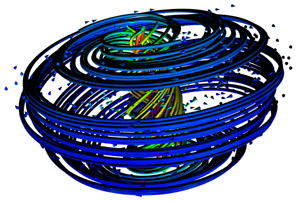

You've reached the personal pages of Dr. Richard Boardman at the University of Southampton. I'm a research fellow in the School of Engineering Sciences. More specifically, I can be found in either building 5 or building 25 depending on the time of day!
I'm working on the μ-VIS project, handling data management, analysis, reconstruction, image processing, workflows, algorithms, as well as development work with CT scanners.
We were featured on the BBC Breakfast show in December 2010. The 'Colossal pliosaur fossil secrets revealed by CT scanner' story is still on the BBC's website.
Please visit the μ-VIS site for more details, including beam time applications. General enquiries can be sent to muvis@soton.ac.uk.
The CT centre is within the Engineering Materials Group.
Internally, you can also refer to the μ-VIS wiki for matters involving the CT process, including acquisition, reconstruction, image processing and finite element mesh generation (internal only).
I used to work in the School of Chemistry with Professor Jon. Essex and in the Computational Engineering and Design group with Professor Hans Fangohr, in the e-Science centre inside SES.
Here is my thesis. It was on computer simulations of magnetic nanostructures. Warning: it is a shade over 10 megabytes as a PDF document. I've put up a rudimentary HTML version here using latex2html. It's not quite so pretty, but it suffices as a quick reference.
Here's a list of my research interests:
Casually looking for my Erdős number, I see the following:
So with minimal investigation, this appears to be 5. Some inspiration from Denis Nicole's page. However, a recent update: it seems that a 2002 paper reduces this to 4:
Micromagnetism is the behavioural study of ferromagnetic materials at micrometre length scales. This is an important area of research as modern storage devices are requiring denser media capable of storing large amounts of data for long periods of time.
At present hard disk drives such as those found in computer workstations and servers rely on a process whereby a platter is "sputtered" with irregular magnetic grains, and many hundreds of these grains are required to reliably store even a single bit of data. This results in a capped theoretical data density for the platter in a hard disk drive of around 200 gigabits per square inch of platter - around 1.5 terabytes in a 3.5 inch disk with four layers.
One of the possible solutions to this problem is to use a regular, or "patterned", medium, where equally sized and spaced tiny magnets are used; only a single one of these "nanomagnets" is required to store one bit of data, giving an areal data density of 2 terabits per square inch, allowing the production of hard disks with a capacity of 15 terabytes over four platters.
Another application of micromagnetism is with research into magnetoresistive random access memory - MRAM. MRAM behaves in the same way to standard dynamic random access memory (DRAM) in computers, only with extra density and faster access times. The non-volatile nature of MRAM leads to persistence of state (it "remembers" its contents even when powered down) and low power consumption; a characteristic particularly attractive to manufacturers of mobile devices such as laptops and cellular telephones.
We have investigated the suitability of nanoscale "droplets"; tiny dome-topped spheres which can be produced through chemical self-assembly processes - at diameters of 200nm they possess interesting characteristics exhibiting the combined properties of other shapes, such as the uniform rotation of magnetisation. In order to minimise their internal energy, an examination of the magnetic microstructure reveals vortex penetration, movement and exit, as shown in the images.

Until recently computational micromagnetics, particularly when three-dimensional problems are considered, has been prohibitively expensive in terms of computational power. Modern high-performance workstations are capable of performing micromagnetic simulations within a few days.
Within the e-Science centre, many simulations can be performed in parallel on the 814 processor Iridis computational cluster (AMD Opterons and Intel Xeons), dramatically increasing the number of potential micromagnetic scenarios which can be simulated in a given period of time. The power provided by this facility allows dependence studies to be performed with respect to size, time and shape. Additionally, micromagnetic simulation is being used as a test case application for Grid techologies.
At present, I am working on the BioSimGrid project, which aims to make the results of large-scale computer simulations of biomolecules more accessible to the biological community. Such simulations of the motions of proteins are a key component in understanding how the structure of a protein is related to its dynamic function.
I have worked with scientific visualisation software primarily for
assisting with magnetic nanostructure analysis. I use mostly the Visualisation
Toolkit with front-ends provided by Prabhu Ramachandran's MayaVi, to which I tacked in
the WaveFront VTK module, allowing rendering to take place in
third-party 3D modelling software. Invariably I would end up using the
Renderman RIB format for final proof images, but it's fun
to play.
I've built a few "miniclusters" which were effectively proof-of-concept machines for a number of problems, particularly memory scaling observations in micromagnetism, but the general purpose Iridis supercomputer was where I ended up performing most of my simulation work. This cluster consists of 600 2.2GHz AMD Opterons and 214 1.8GHz Intel Xeons providing access to over 700 gigabytes of memory.
The Iridis-pi cluster captured a few people's attention. There's an article on The Register amongst other things, only a short Google search away. Pocket-sized clusters do have a very useful purpose in figuring out how to code for supercomputers, as they have the same classes of problems.
Site contents are copyright © 2003-2011 Dr. Richard Boardman. Please contact me if you would like to reproduce anything on this site at rpb@soton.ac.uk